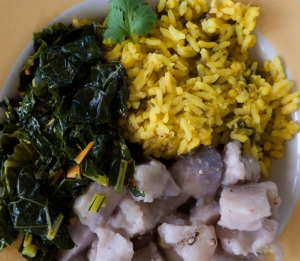Kaneohe, January 2015
Ayurveda is the oldest traditional health system. Ayu is the living structure of the senses, consciousness and spirit and Veda means experiential, practical knowledge. Together it is the science of long, healthy living.
Health in an Ayurvedic sense is defined as:
The three bioenergetic doshas Vata, Pitta and Kapha are in balance (see below).
The metabolism/ digestion functions well.
The tissues are healthy and well developed and the waste is adequately moved out.
The sense and touch organs work properly.
The soul and spirit are in a state of permanent happiness.
Sushruta Samahita, 15.38, 1 Century BC
Health defined by the WHO, Geneva, 1948
“Health is a state of full physical, mental and social well-being and not just the absence of disease.”
The big difference is that the ayurvedic approach includes our spiritual state, in health or in illness. Ayurveda looks at each individual’s specific energetic make-up and its current state of balance or imbalance. This is based on the three doshas, “biological substances which move within our bodies, our own inner equivalents of air, fire and water. Western physiology offers no real counterparts for these, and yet they are key part of Ayurvedic practice.” Amadea Morningstar.
The three doshas are Vata (air), Pitta (fire), Kapha (water, earth) and the unique combination of these energies define each of us and is called our constitution. Through a dosha quiz you can find out your particular constitution.
It means that the best way to approach eating or exercise for example is different for each individual. Ayurveda gives you the ability to develop a diet, lifestyle that suits YOU. Of course, this is best accomplished with the help of an experienced ayurvedic practioner. Ayurveda also takes in account the time of year, the current phase of life and your attitude towards food and your self.
We do not count calories or separate the ingredients into fat, carbohydrates or trace elements. How we experience food as an individual and especially how we digest it becomes more important. All foods have specific qualities and energies, which work better for one dosha or another, which help us to choose what to eat. Another important element is how to combine different ingredients. For example milk combined with fruit creates a toxic mix in your stomach that is not digestible. These toxins stay in you digestive system and eventually cause disease. The same goes for drinking cold milk. The non-digested substance or metabolic toxins in your digestive system is called ama.
Milk and milk products have gotten a bad rap and for a big part rightly so, since industrial milk production, the treatment of the animals, antibiotics, hormones, etc make most milk indeed toxic. There are also genetic and historic reasons why many people besides people from India and Northern Europe often can’t digest milk.
Milk should come from the best possible source (organic), ideally be raw (in the US possible through cow-shares), be whole, drank by itself at room temperature or warmed with mucus eliminating spices. I assure you the night-cap that I drink most of the time is one of the most divine foods that I have experienced during my 65 years on this planet and is very helpful for my sleep (whole organic milk heated with ghee, nutmeg, cardamom, cinnamon and honey in the cup – do not heat honey).
There is a lot of confusion about ghee. Ghee is purified butter (organic, unsalted) that is boiled and filtered, basically removing all congestive qualities, which gives it its high energetic quality. Without addressing spiritual considerations too much, I can assure you that the people who are my ayurvedic inspiration also aim for the highest consciousness. That includes myself. But if you want to stay away from ghee for ethical/moral reasons you can use sunflower, sesame (heating) or coconut oil (cooling) and many others. Note though “ghee is good for all doshas and strengthens agni (digestive fire), which those other oils don’t do. “ Myra Lewin In my experience ghee holds all ingredients together and helps to transform them into the satisfying dishes that I had not known before I experienced ayurveda. It can also be used as topical ointment and has many medicinal applications when combined with the appropriate herbs. Here is a video on how to make ghee.




Pingback: On the Soul of Cooking and How to Love Yourself | Dieter Runge